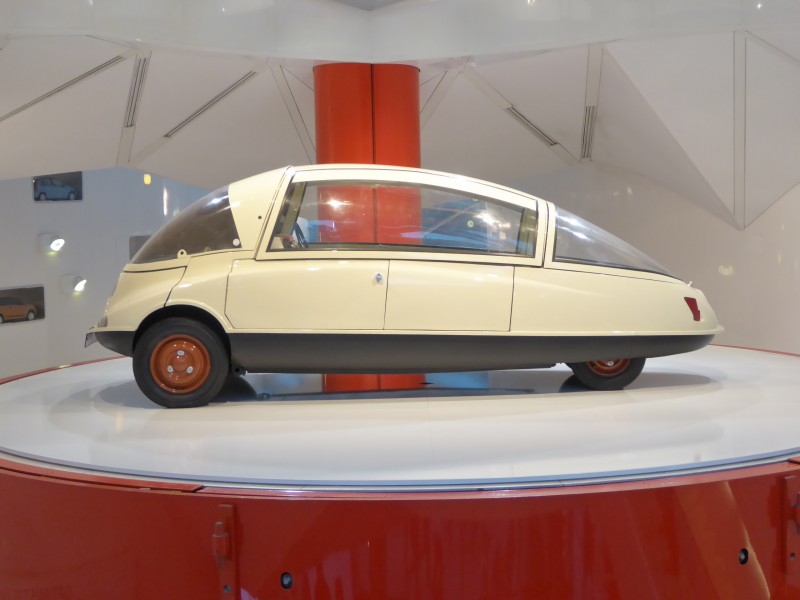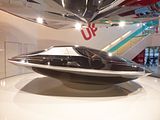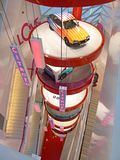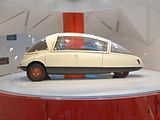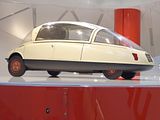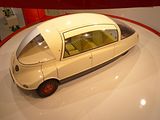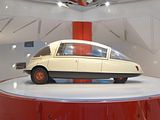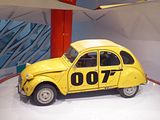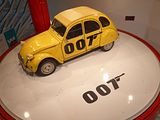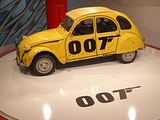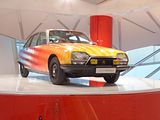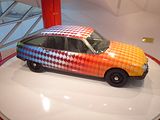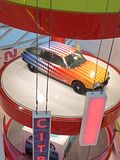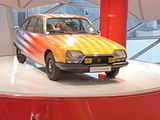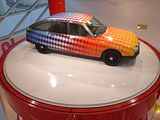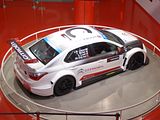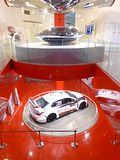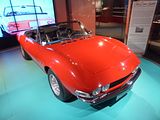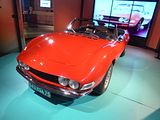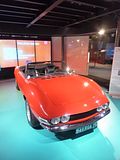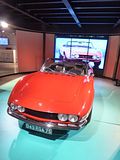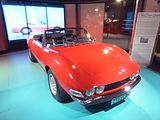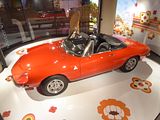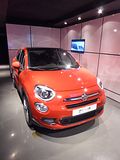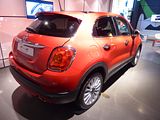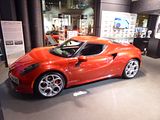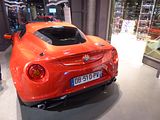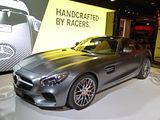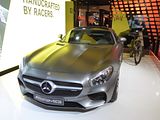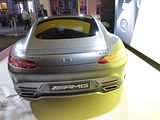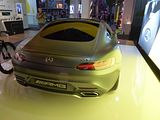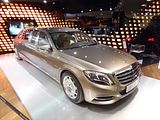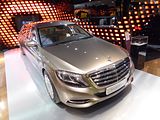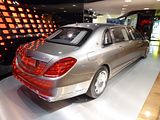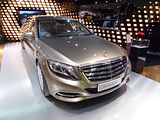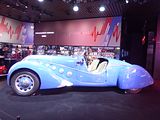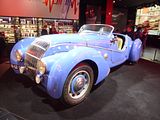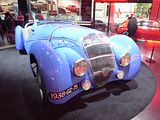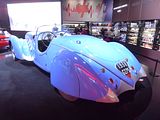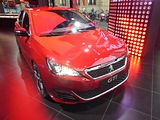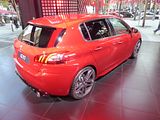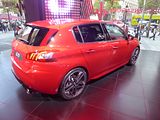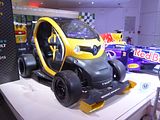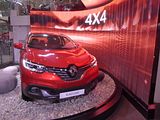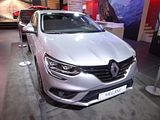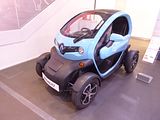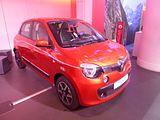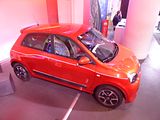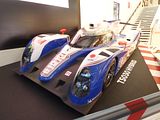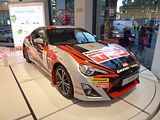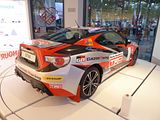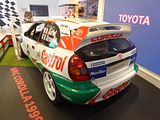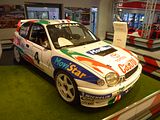The business trip to some distant location. Maybe even a foreign country. Sounds great, doesn’t it? The reality, as is well known by those of us for whom these excursions are a feature of the working week, is usually quite different. Too much packed into the agenda, a corporate expense policy which these days tries to save money on everything from whether you even go or not, to where you sit in the plane to the hotel that you get to try to sleep in. Most times, all you will see will be an airport, a taxi ride, the office and your hotel. I have previously joked that you may even only be sure which country you are in by the language on the coffee machine. So when my schedule came up with a 3 day education event at our offices in Paris, mid-week, I was not optimistic that I was going to get the chance to do anything remotely touristy or car-related. However, a combination of that very travel policy and the fact that by the time I had all the requisite approvals, it was close to the event, meant that whilst the office was in the suburbs (not strictly in Paris, as it lies outside the Périphérique), the hotel was on the other side of the city, right out at Orly Airport. That meant a daily trek of an hour or so each way on a combination of the OrlyVal, a couple of RER trains and a bus. Furnished with a 3 day travel pass, though, it did mean that I could interrupt the journey back on the evening. And as luck would have it, that journey ran parallel with the Champs-Élysées, so getting off and ambling down what is perhaps Paris’ most famous street, and taking in the six car showrooms that are always worth a look on every visit to the city was a real possibility. At the end of the first full day of class, I duly got off the Metro right by the Citroen showroom, C42, only to find it closed, as they were clearly changing all the exhibits. A stroll back towards to the Are de Triomphe also drew blank at Peugeot, whose showroom closes earlier than the others. That gave me four places to go and inspect, all of which were well worth the interruption to my journey back to the hotel. My visit coincided with a period of glorious autumn sunshine, with barely a cloud in the sky all three days (such a shame to be in a windowless auditorium the rest of the day!), so I decided to break the journey again on the last night I was there, which meant that I was able to visit Peugeot and Citroen, and then to watch the traffic going round the Arc de Triomphe as the sun set and the lights were switched on, before heading back for a final night at the Orly Airport Hilton. I am glad I did, as there was plenty of interest in these two showrooms, even if I was hustled out of the Citroen one so they could close a full hour earlier than the signs advised that they would be doing.
CITROEN
Theme for the autumn 2015 display in the Citroen C42 building is, in Citroen’s own words: “CITROËN [RE]MIX!, an intriguing assortment of cars and concepts, past and present! For an even more vibrant experience, visitors can mix the C_42 venue lighting themselves, using the Light Mix feature. What a way to brighten up the autumn!” Emerging from the Metro station that is literally outside the showroom, I headed into see what that really means. “Intriguing” was not an understatement! Over the years I have seen some pretty bizarre concept cars both with my own eyes and in pictures, but the sight that greeted me on entering the Citroen C42 building had to count as one of the oddest ever. Looking like something that was created for a particularly zany sci-fi film, this “car” was created in 2010. Look closely, and it does have a front and a back, and there are head- and tail-lights on it, though practicality would indeed seem to be some way off its design criteria. There was very little information about it at the venue, so I had to resort to the trusty Google after my visit to find out more, as I do not recall seeing this “UFO” when it was first conceived. It was the work of a French designer, Ora-ito, and it does indeed officially resemble the shape of an UFO, which apparently is supposed to be something of a “mutated” version of the Citroen DS. Shaped like a flying saucer, it does have a particularly aerodynamic body. The concept was supposed to indicate what form transport might take in the future, and the design of the UFO concept car was a combination of science, art & engineering. There are no wheels attached to it, so how it would actually move is less than clear. Its creator claimed that the UFO was not designed as just another concept car but instead it was supposed to convey a universal message to the car industry about the future of transportation through the eyes of an artist.
The Citroen showroom comprises a tall building, with a series of display platforms mounted above each other, half of which are accessible by the public, as they ascend the building, and the other half of which are effectively on mezzanine floors. so only visible from the stairs and landings which go round three sides of the building.
Up a floor from that bizarre UFO was another rather unusually styled car. Unlike the UFO, I’ve seen this prototype before, as it was shown at Rétromobile in 2014, and it also made an appearance in the UK at the Classic Car Show at the NEC back in 2009. One of a series of concepts created by Citroën from 1955 to 1956 under the direction of André Lefèbvre, the idea behind this one was to produce a water drop-shaped, very lightweight vehicle, which would be more modern and smaller than the 2CV. The overall look of the vehicle was quite similar to the Messerschmitt bubble car. It was equipped with the same 425 cc engine as the 2CV. The vehicle was also nicknamed Citroën Coccinelle (Ladybird in French).
A much better known car from the Citroen Conservatoire was this 2CV, complete with bullet holes. This little Citroen was a star of the silver screen, one of the three 2 CVs used in the 1981 James Bond film “For Your Eyes Only”. It carried Roger Moore and Carole Bouquet and also appeared on the film poster! As is often the case with cars used in the movies, all is not quite what it would seem, as the cars that were used in action shots had a Citroen GS engine squeezed under the bonnet to give them a little more oomph than the standard car.
I had not seen this car before, a Citroen GS Arrows. An Art Car, this is a GS revisited by the artist Jean-Pierre Lihou in 1976. The tangy colours, all 73 shades of them, and winding arrows are said to materialize the Energetism concept developed by this visionary artist. They were applied by hand, taking 40 litres of paint.
Production cars in the display included the latest C4 Grand Picasso and a C4 Cactus a large part of which was enclosed in a box.
In the basement there was a reminder of Citroen’s exploits in motorsport. I initially thought that this was the World Rally Championship C4 Élysée WRC car as driven by the likes of Kris Meeke, but in fact it is the superficially similar World Touring Car Championship entrant. Citroen entered this in 2013 and within days of announcing that they were doing so, Sébastien Loeb signed up to move from the world rallying to Touring Cars. He has been joined by José María López, Yvan Muller and Ma Qing Hua, for the 2015 season.
FIAT GROUP
This showroom is just off the Champs-Élysées and is in a building with a small footprint, so like the Citroen building you need to go up and down the stairs to see everything. Frankly, if no-one had told me that, and just let me see what was on the ground floor, I would have left happy. As well as showing a representative sample of cars from a number of marques in the FCA Group, classics were included, a couple of classics were included, to reflect a theme of Cabrios designed by Pininfarina. My personal favourite was the Dino Spider which had a prominent place in the middle of the showroom. One of my all time favourites, the dealer staff said that these cars now sell for €150,000 in France. And no wonder. Magnifique, as the locals would say!
Nearly as nice and an awful lot more affordable was the Alfa Duetto Spider which was berthed in a little cabin part way downstairs was also very covetable.
Production cars in the basement included a 500X, a Jeep Wrangler Rubicon, a Jeep Renegade and an Abarth 595C.
Back on the ground floor was an Alfa 4C Competizione which seemed to be of particular interest to the only other customer who was in the showroom whilst I was there.
Final car on show was one of the facelifted Series 4 Fiat 500 models. The new interior is nice, I am less convinced of some of the external styling details, especially the rear light clusters with a large body coloured square in their centre.
MERCEDES
Attention grabber here, at the front of the showroom, was the new Mercedes-AMG GT-S, to give the car its full name. After some very flattering press reviews in mid year, the first customer cars are starting to appear on the road now. Aimed more directly at the 911 than its more costly and heavier SLS AMG predecessor, this car looks stunning from some angles and never less than pretty good from all the others.
Mercedes have played things very safe with their new upper-medium sized crossover, the GLC. Taking the place of the rather boxy GLK, this looks very much like a C Class Wagon on stilts, not unlike a number of rivals who have equally played it safe. Will that simply steal sales from the regular C Class? Time will tell.
Far more controversial is the Mercedes-Maybach, seen here in extended long wheelbase guise. The first modern Maybach missed the spot, and when it was discontinued, many thought that this was the end of the line for the resurrected marque. But no, it has staged another appearance on what is clearly little more than a gussied up (and massively more costly) S Class. Is that what the market wants? Somehow I doubt it, but I could prove to be very wrong, of course.
More familiar cars in the showroom included a B Class and a GLA.
PEUGEOT
There’s less space in the Peugeot showroom than the others, so you only tend to find 4 cars to look at. The one in the middle more than made up for this, though. A 302 Darl’mat Sport is a rare car, as just 79 of these were made. Emile Darl’mat (1892–1970) was the creator and owner of a Peugeot distributor with a car body business established at the rue de l’Université in Paris in 1923. In the 1930s the firm gained prominence as a low volume manufacturer of Peugeot-based sports cars. Business was interrupted by the war, but at least one prototype was kept hidden throughout the period and directly after the war Darl’mat returned to the construction of special bodied Peugeots, although in the impoverished condition of post-war France business never returned to the volumes achieved during the 1930s. The first cars were built at Darl’mat’s workshops in Paris; however, during the 1930s the special bodied Peugeot-based coupés and cabriolets became increasingly integrated into the Peugeot range. During the second half of the decade, starting in 1936, Darl’mat’s Peugeot-based coupes and cabriolets were built at the Peugeot plant in Sochaux. The best remembered of the Darl’mats is a sports car based on the Peugeot 302, like this one. Regular 302s were only built for a year, until the slightly smaller and volume selling 202 was ready in 1938. 25,000 of them were sold in Saloon, Coupe or Convertible guise. Darl’mat produced the Sport version like this one, in 1937, using the 4 cylinder 1991cc engine from the larger 402. With a slightly different body, several Peugeot-Darl’mat 402 “Spécial Sport” models raced at Le Mans with success in 1937 and 1938, with 5th overall and First in Class. The cars were costly, but despite this, they sold quickly and earned a fine reputation for their exciting dynamic characteristics. Sadly, the escalation of WWII put an end to the production of Darl’mat’s remarkable sports cars. In all approximately 105 Darl’Mat Specials were built: 53 roadsters, 20 coupes and 32 cabriolets.
Production cars on display included GTi versions of the 208 – on sale for a couple of years – and the brand new 308, a car to rival the Golf GTi and Seat Leon Cupra.
RENAULT
With an average of 6000 people a day coming through the doors, the Renault showroom is always a busy place. As well as the cars presented on the ground floor, and a shop selling branded merchandise, there is a rather good brasserie upstairs, which I have eaten at on previous visits, and enjoyed. This time, my visit was confined to the ground floor, and the cars. Displays are changed several times a year, sometimes with an over-arching theme, and sometimes not. The latter is the case at present. Doing its best to lure the crowds in were a duo of Formula 1 related cars right at the front, visible from the street. One was a replica of a true race car, a Formula 1 Red Bull race car, and with it was the Twizy F1. A £1 million pound one-off, this wacky design combines Formula 1 technology with the odd-beat all-electric Twizy styling. The changes were made by the Renaultsport F1 team, and as well as the usual 17bhp electric motor, there is a KERS electric boost system from the F1 car, which ups power to 97bhp for 13-second bursts for this 564kg car. As well as racing slicks and a Formula Renault 3.5 steering wheel, other changes include the F1-style carbon-fibre front splitter and rear spoiler. With the Twizy still only boasting a top speed of 68 mph, they probably don’t do much for downforce, but they certainly do ensure that it looks the part and the 0 – 60 second time of under 7 seconds makes the Twizy decently brisk.
Commercially far more significant is the new Kadjar. Sharing much under the skin with the Nissan Qashqai, this family-sized crossover has been on sale in Europe for a couple of months, and already it is proving popular. Priced to undercut its in-house rival, it should do well in the UK, too, where it has just gone on sale. A couple of models, both in a bright shade of scarlet which suits the car far better than the greys that seem to populate the streets of Paris, just as they do London and other European cities these days.
We will have to wait a while longer for the car that was in the very middle of the showroom, the new Mégane. This was the first of the fourth generation models that I have seen in the metal, and it looked rather better than the initial photos suggested. The display car was locked, and the staff were not going to unlock it, so I had to assess the interior through the windows. It looked promising, with quality levels at least on a par with domestic rival Peugeot 308, the car that la Régie must beat on the home market if the new Mégane is to achieve its potential.
The car we will wait for in vain was parked behind it, the new Espace. Slightly worryingly, I did not see a single one of these on the road during my stay. Although the interior is a lot plusher and of higher quality than its predecessors, the feeling of spaciousness has gone, with this fifth generation Espace feeling more like a crossover rather than a Minivan. Given its price and provenance, it’s probably a wise decision not to try to sell it in the UK.
Tucked away at the back of the showroom were a number of more familiar Renault production models, with the electric cars almost hidden away to the left, and a new Twingo and Clio at the other side. Although I quite like the external styling of the Twingo, the interior looks and feels particularly cheap, and there are a lot of hard edged plastics just as evident now as they were at launch.
TOYOTA
Toyota’s successful Endurance racer, the TS030, which won just about everything apart from le Mans, was on a display plinth as you entered the Toyota showroom. The TS030 marked Toyota’s first works entry at the 24 Hours of Le Mans since the Toyota GT-One was entered in the 1999 race, and is notable for being the first petrol-powered hybrid car to be entered in the FIA World Endurance Championship. The TE030 features the Kinetic Energy Recovery System (KERS) regenerative braking device to charge a supercapacitor. The extra power is directed to the rear wheels. Under the 2012 Le Mans rules they were allowed to use the system at any speed, unlike Audi who had elected to send power to the front, with a restriction to a minimum speed of 120 km/h. Expected to make its debut at the 6 Heures de Spa-Francorchamps in May 2012, a testing crash at Paul Ricard had damaged the chassis beyond repair, so the team was forced to delay the TS030’s debut until that 24 Hours of Le Mans in June because of the time needed to produce a new monocoque. On lap 82 at Le Mans, Anthony Davidson’s TS030 became airborne after a collision with Piergiuseppe Perazzini’s Ferrari, and collided hard with track barriers. Davidson suffered two broken vertebrae from the incident. The second TS030, which had briefly led the race before the accident, retired several hours later after an engine failure. After finishing in second place at the 6 Hours of Silverstone, the TS030 Hybrid took its first pole position and victory at the 6 Hours of São Paulo race, held at the Autódromo José Carlos Pace in São Paulo, Brazil. It finished the 2012 season with two more victories at the 6 Hours of Fuji and the 6 Hours of Shanghai. Toyota started the 2013 schedule with two 2012 spec TS030’s. Both showed stunning pace in qualifying at the first race of the season, the 6 hours of Silverstone, with the #7 machine qualifying more than 3 seconds ahead of the nearest Audi, whilst the #8 sister car qualified second. The race however was at best uneventful, with neither car being able to match either Audi’s pace, finishing third and fourth overall having struggled in the first few hours of the race with tyre management. The second round at Spa-Francorchamps would see Toyota debut the new 2013 specification TS030 featuring a revised aerodynamic package and including an updated monocoque. After a close qualifying session, the updated #7 ran near the front of the race for the first three hours, before retiring due to overheating brakes as a result of a malfunctioning energy recovery system. With the rear brake assembly designed to be assisted with certain amounts of mechanical retardation provided by the hybrid recovery system by design, it did not provide the deceleration when malfunctioning, thus overloading the conventional rear brakes. The sister car remained in fourth for the rest of the event, closing what was a mixed outcome for the team. Post race, technical director Pascal Vasselon complained that his team’s analysis from Spa showed that the current Balance of Performance significantly favoured Audi’s turbodiesel powerplant over its own normally-aspirated petrol engine, calling the ACO and FIA for a more favourable balance of performance to be applied before Le Mans. As agreed at the start of the season, the FIA and the ACO reviewed the technical regulations at the end of May 2013 to adjust the performance between petrol and diesel LMP1 cars for the remainder of the 2013 WEC Championship. From the 24 Hours of Le Mans onwards, petrol-engined cars were permitted an additional 3 litres of fuel capacity. It was not enough to give the Toyota victory, though, with Audi once again claiming the chequered flag.
The rest of the ground floor was given over to the facelifted Auris. Allegedly an improvement on what went before, the looks don’t appeal to me, though they are not as bizarre as some of the recent offerings from Toyota or Lexus, the interior quality is very humdrum, and everything I have read suggested that whilst the new 1.2 Turbo engine is not bad, the rest of the dynamic attributes are not going to trouble many rivals.
Upstairs the display was more interesting, with further examples from Toyota’s current and back catalogue of motor-sporting legends, such as the current TRD-prepared GT-86 and the Corolla WRC car driven by Didier Auriol.
Joining them was the GT-One, sometimes referred to as the TE020. This car came about as following the end of the Group C era around 1994, Toyota decided to alter its plans in sports car racing by moving to the production-based GT classes for 1995. Two different styles of car were developed: the first was a heavily modified Toyota Supra, referred to as the Supra LM, which would use a turbocharged 3S-GT (503E) inline-4; the second was a custom built car designed specifically to be a racing car, though to meet homologation regulations, a small number of road car versions would have to be built.. The result was based on a heavily modified MR2, and known as the SARD MC8-R, and it used a custom built Toyota turbocharged V8. While the Supra performed admirably in 1995, the MC8-R would appear superior for 1996. With development of high powered supercars for the GT classes at the time, Toyota decided that a car similar to the MC8-R, which was intended as a race car first, would be better suited to continuing Toyota’s development of a GT car. Thus Toyota announced they would skip the 1997 24 Hours of Le Mans to be able to develop their new GT car for 1998. Turning to Toyota’s European arm based in Cologne, Germany, Toyota Team Europe (TTE) and Dallara were charged with development of the new GT car. The one-year hiatus enabled TTE to look at what the competition was developing for the GT class, and exploit it to their benefit. In 1997, both the Mercedes-Benz CLK GTR and the Porsche 911 GT1 were dominant cars in their class that exploited loopholes in the rules in place at the time. Each car was a custom built super car of which only a small handful of production cars were built to homologate it. TTE realised that they would actually only need to build a single production car in order to meet homologation regulations, thus allowing TTE to have a car that would never truly be sold to a customer, meaning that any driver luxuries could be left out. All GT based cars were required to have storage space, capable of holding a standard sized suitcase, in order for the car to be considered not only production based, but usable by the public. Mercedes exploited this by putting a small cubby hole into an unused area underneath the rear bodywork, although it was not as easy to access as a normal boot. Toyota, in their interpretation of the rules, were able to convince Automobile Club de l’Ouest (ACO) officials that the car’s fuel tank, normally empty when the car is scrutineered before the race, was allowable as a trunk space since it could, theoretically, hold a suitcase. The result was the GT-One. TTE designed and manufactured the car’s carbon fibre chassis and bodywork in-house, while Toyota supplied an upgraded version of the engine they originally used on their Group C cars, the R36V 3.6 L Turbo V8. TTE developed the only two GT-One road cars built, required in order for the race car to qualify as a road car-based Grand Tourer. They were painted red and fitted with a basic interior. One was put into a museum in Japan, the other is usually displayed at Toyota Motorsport GmbH in Cologne.
As ever, therefore, this proved a worthwhile diversion on my journeys back across Paris. For those who are visiting the area, and strolling along the Champs-Élysées, and that’s likely to be a good percentage of visitors to the city, then stopping off in some or all of these showrooms comes highly recommended. Entry is free, there is no sales pressure, and you will see an interesting combination of current and past models from each of the brands.

